Social Welfare
Employment
The employment structure of Korea has undergone remarkable changes since the beginning of industrialization in the early 1960s. In 1960, workers in the agricultural, forestry and fishery sectors accounted for 63 percent of the total labor force. However, this figure dropped to 7.3 percent in 2007. By contrast, the share of the tertiary industry (service sectors) grew from 28.3 percent of the total labor force in 1960 to 75.0 percent in 2007.
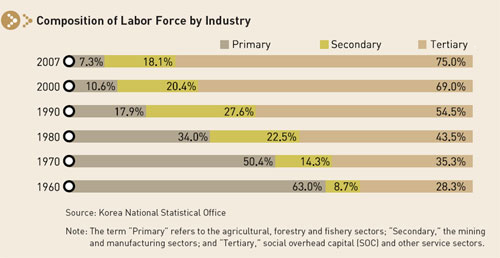
In the latter half of the 1970s, the Korean labor market went through a series of important changes. Korea emerged as a competitive country in the global market with its labor-intensive industries such as textiles and footwear.
In the 1970s and 1980s, the Government focused on the labor supply and training in response to economic growth. The cultivation of a skilled workforce and provision of job placement services for low-skilled workers were major policy pursuits to ease labor shortages resulting from industrialization.
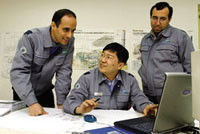
Doosan Heavy Industries' training center teaches foreign engineers about power station construction and operation
In the early 1990s, in order to systematically cope with unemployment problems caused by a slowdown in economic growth, the Government passed several major laws, including the Employment Insurance Act (1993), the Basic Employment Policy Act (1995) and the Vocational Training Promotion Act (1997), setting a foundation for employment policies.
In October 1999, the Government also strengthened the social safety net to cope with unemployment by extending the coverage of employment insurance to all workers, including part-time and temporary workers.
Individual Action Plans (IAPs) for recipients of unemployment benefits have been expanded to cover both young people and the elderly as a means of encouraging them to look for jobs more actively.
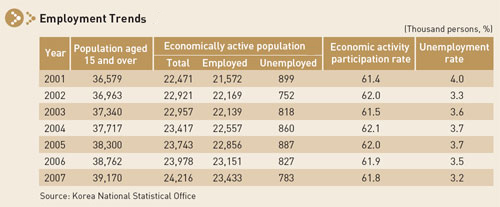
Also, in response to growing demands for lifelong competency development, the Government has gradually expanded investment in vocational training. In reaction to the trend of low fertility and an aging labor force, various measures have been implemented to increase the employment rate of women. They include such measures as easing discrimination in employment and supporting reconciliation between work and family life as well as tackling the problem of career breaks caused by pregnancy and childbirth.
A variety of other measures have been implemented to expand and stabilize employment of the elderly, such as extending the retirement age, reforming wage systems and reducing discrimination and prejudice based on age.
Housing
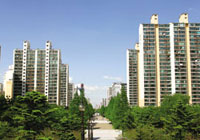
Apartment complex in Seoul
This rapid population growth in urban areas led to a housing shortage and spiraling land prices in cities. In order to solve the housing shortage problem and stabilize housing costs, increasing the supply of land available for residential construction and the building of small housing units have continuously been among the top priorities of the Government.
In 1988, the Government established and promoted its “Two Million Housing Units Construction Plan” for the period of 1988-1992. Actual housing construction for the period totaled 2.7 million units, and this massive supply contributed to a sharp stabilization of previously rising housing prices.
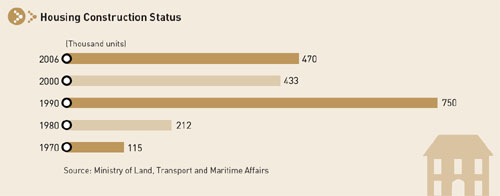
The Government supplied an average of 500,000 to 600,000 housing units per year from 1993 to 1997. As a result, the housing supply ratio increased to 107.1 percent in 2006 from 72.4 percent in 1990.
With rising land prices and a marked preference for modern lifestyles, the rate of people living in apartment buildings has continued to increase. In 1985, only 13.5 percent of housing units were apartments, but in 2005, 52.5 percent of all housing units were apartments. In Korea, most apartments, like condominiums in America, are owned by individual families.
Health and Medical Services
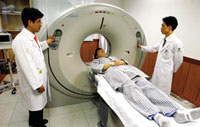
High-speed three dimensional CT (computed tomography) examinations
These improvements are all directly related to improvement in diet as well as in available health and medical services.
People are increasingly relying on medicine and medical services and the share of medical costs to total household expenditures has increased accordingly. In 1985, national health expenditure per capita was 85,000 won which increased to 840,133 won in 2003.
Health care in the form of medical insurance and medical assistance was first introduced in 1977. However, the coverage rate was only 29.5 percent until 1980. As of Dec. 2005, 96.4 percent of the population had access to health insurance, with the remaining 3.6 percent being able to receive direct medical assistance.
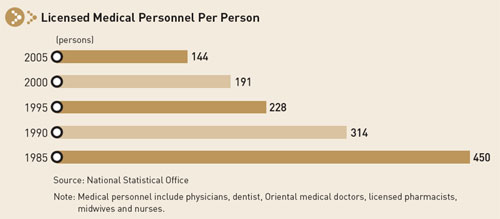
The supply of hospitals and medical personnel has continuously increased. The total number of hospitals and clinics in the nation (including Oriental medicine hospitals and clinics) was 11,188 in 1975, which increased to 51,247 in 2006. Meanwhile, the number of licensed doctors, which totaled 16,800 in 1975, increased to 88,214 in 2006.
National statistics for 2004 showed that there was one physician for every 500 persons, one dentist for every 2,320 and one pharmacist for every 899.
Social Security
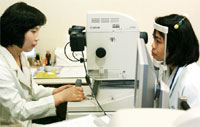
Free medical checkups are now available to foreign spouses of Korean nationals
While the primary goal of the above systems is to provide minimum guarantees to the economically active population in case of economic difficulties, there are also welfare programs for those not economically active. These public subsidy programs consist mainly of two parts: subsidies for living expenses and medical assistance.
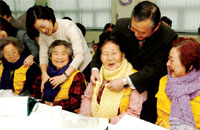
Treating seniors with respect
Policies that have been implemented to improve the welfare of the elderly include the provision of direct subsidies to the elderly living under the subsistence level, the expanding of employment opportunities for older people by developing suitable jobs and opening job placement centers, the strengthening of health care systems for the aged, and the opening of various types of public facilities for the elderly.
With the strengthening of social security measures since the late 1980s, awareness of the needs of the disabled has also been increasing.
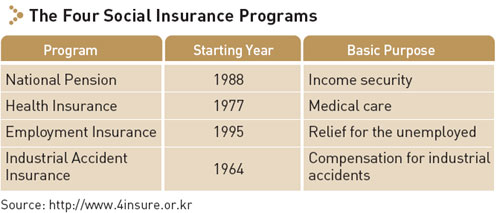
Women

Korea's first astronaut, Yi So-yeon
With the establishment of the Republic of Korea in 1948, women achieved constitutional rights for equal opportunities to pursue education, work, and public life.
In March 2005, the Government took another big step toward a gender-equal society by abolishing the household head system, which had been a major example of discrimination against women. The abolishment of this system laid the foundation for a new family culture based on democratic values and gender equality.
As economic development proceeded and the living conditions of Koreans improved, the educational attainment level of women also increased.
In Korea, elementary and middle school attendance is compulsory and free. As of 2005, one hundred percent of the nation's children attended elementary school. The percentage of middle and high school attendance was nearly the same for girls and boys. A total of 82.7 percent of male high school graduates go on to college or university while 80.4% of female students do. The difference here is minimal, and in fact, the enrollment of women in college is notably higher than the world average.
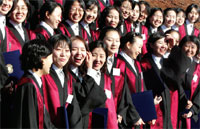
Female prosecutors smile during their official appointment ceremony at the Gwacheon Government Complex
Korean women today are actively engaged in a wide variety of fields making significant contributions to society.
Recently, women have been making major inroads in some areas, particularly in the government sector. For example, female members of parliament have increased considerably; there were 16 (5.9%) in the 16th National Assembly (2000-2004), and the number has increased to 43 (14.4%) in the 18th National Assembly (2008-2012). In the latest bar examination, 35.1 percent of all successful candidates were women. Among those passing high-level civil service and foreign service tests, women accounted for 49 and 67.7 percent, respectively. Almost all of them were hired as judges, prosecutors, deputy director level civil servants or diplomats.
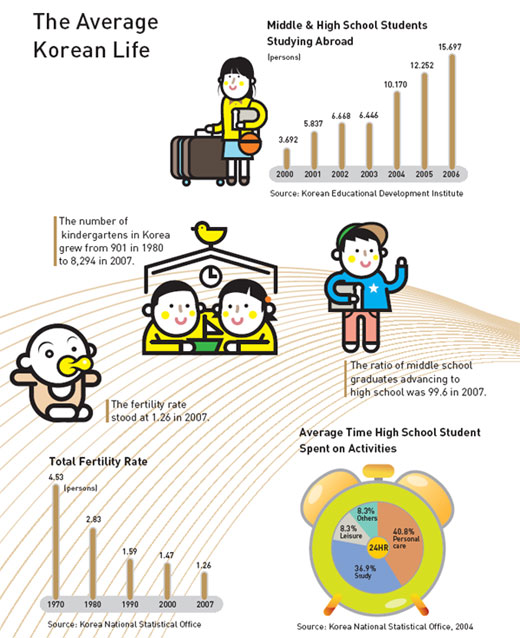
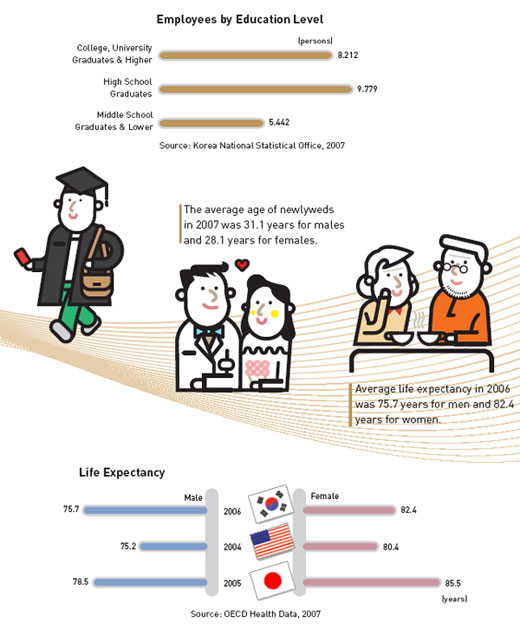
|
|